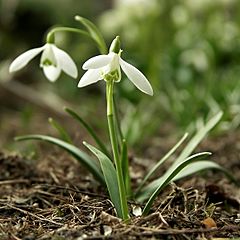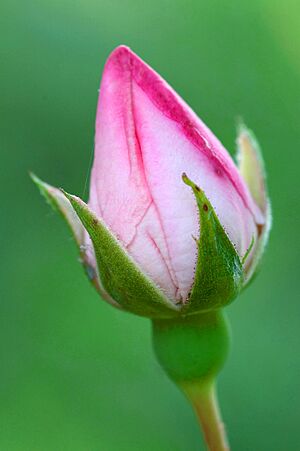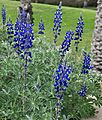Flowering plant facts for kids
Quick facts for kids Flowering PlantsTemporal range:
Lower Cretaceous – Recent |
|
|---|---|
 |
|
| Snowdrop | |
| Scientific classification | |
| Kingdom: | |
| Subkingdom: | |
| Division: |
Angiospermae
|
| Classes | |
|
Traditional groups: |
|
Flowering plants, also known as Angiosperms, are the most common plants on Earth today. They are a type of seed plants, just like gymnosperms. But there's a big difference! Flowering plants grow flowers and keep their seeds safe inside a special part called an ovule. Gymnosperms, on the other hand, have "naked" seeds, often on cones or open structures.
Contents
What Makes Flowering Plants Special?

Flowering plants have developed some amazing features. These special traits helped them become so successful. They evolved these features as they became different from gymnosperms.
Flowers: The Plant's Reproductive Parts
Flowers are the most important feature that makes flowering plants unique. They are the plant's reproductive organs. Flowers use bright colours and sweet nectar to attract pollinators. These pollinators are often insects or birds.
Most gymnosperms rely on wind to spread their pollen. But early flowering plants probably used insects for pollination. Today, some flowering plants are wind-pollinated, but this is a later change.
Fruits: Protecting and Spreading Seeds
After a flower is pollinated, the fertilized ovule grows into a seed. The part of the flower that holds the ovule, called the ovary, then grows into a fruit. Fruits are often a clever way to use animals to spread seeds far away. The fruit is made from the carpel and other tissues around it. The carpel protects the ovules inside.
Endosperm: Food for Growing Seeds
Inside the seed, there's a special food source called the Endosperm. It usually forms right after the plant is fertilized. The endosperm gives food to the growing embryo (the baby plant) and its cotyledons (seed leaves). Sometimes, it even feeds the seedling when it first starts to grow.
Special Sexual Parts and Life Cycles
Flowering plants have very specialized sexual parts. This has led to co-evolution with their pollinators. The stamens (male parts) and the male and female gametophytes (reproductive cells) have changed in many ways to suit specific pollinators.
The smaller pollen grains mean that pollination and fertilization happen much faster. In gymnosperms, this can take up to a year! The small female gametophyte also helps seeds grow quickly. This quick growth has allowed many flowering plants to have short life-cycles, like herbaceous plants that live for only one year.
These new features helped flowering plants spread into many different habitats. They now grow almost everywhere on Earth. The only places they don't dominate are the boreal forests (or taiga), which are still mostly filled with gymnosperms.
How Flowering Plants Evolved
Scientists think that a big event happened about 160 million years ago (mya). The entire genome (all the genetic information) of an early plant doubled. This event might have started the family line that led to all modern flowering plants.
Researchers studied this by looking at the genes of an ancient flowering plant called Amborella trichopoda. This plant is found on the Pacific island of New Caledonia. Amborella is a very old type of flowering plant. It has features that might have been present in the very first flowering plants.
The oldest known fossil that is definitely a flowering plant is Archaefructus liaoningensis. It is about 125 million years old and comes from the Lower Cretaceous period. We also have pollen that looks like it came from flowering plants from about 130 million years ago.
Family Tree of Flowering Plants
Here's a simple family tree showing how different groups of flowering plants are related:
- Angiosperms (flowering plants)
Related pages
Gallery
-
Chamaenerion angustifolium, also known as fireweed or rosebay willowherb, is a flowering plant in the willowherb family Onagraceae.
-
Flowers of Malus sylvestris (crab apple)
-
Two bees on the composite flower head of creeping thistle, Cirsium arvense
-
The fruit of Aesculus hippocastanum, the horse chestnut tree
See also
 In Spanish: Angiospermae para niños
In Spanish: Angiospermae para niños











